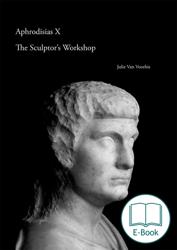Carved marble was a major part of the economy of Roman cities. The material was supplied by local and regional quarries but little is known of the workshops in which the carving was carried out. The Sculptor’s Workshop at Aphrodisias is a uniquely well-preserved facility of this kind supplied by a nearby local quarry. The workshop was located behind the Council House in the centre of town, and when excavated in 1967-1969 it contained remarkable remains from a high-end sculpture business. The monograph offers a complete publication of the archaeology of the workshop itself and of the finds – they include a set of stone-carving tools, a large quantity of sculpture in various states of completion, well-preserved statues (both portraits and mythological figures), and several practice pieces carved by apprentice sculptors as part of their training.
„In the field of Greco-Roman sculpture, Julie van Voorhis’ publication of the Sculptor’s Workshop at Aphrodisias has been eagerly awaited. The workshop features an unparalleled combination of sculptural works in various stages of completion, in a city famous for its sculpture, well-dated and excavated. The scarcity of such workshop contexts from any period of classical antiquity makes this a rare occasion to trace the practical processes of sculpture production and refurbishment in the period in which the workshop was active and potentially beyond. A thorough presentation of this material therefore matters considerably for many further lines of enquiry. In this, van Voorhis has succeeded beautifully. (...)
The book is beautifully produced, and apart from rare spelling mistakes and one or two errors in plate number references, is as clear and stylish in its presentation as it is in its contents. The scholarship presented here in such a condensed form will be a fertile breeding ground for subsequent lines of investigation, and so this book is invaluable as a starting point as much as it is a culmination of decades of research.“
Von: Helle Hochscheid
In: BMCR (Bryn Mawr Classical Review) 2020.06.23
The series is dedicated to the publication of archaeological research at the ancient site of Aphrodisias. Aphrodisias was a prosperous city of the Roman period, well known for its cult of Aphrodite and its marble-carvers, and it has remarkably preserved remains from the second century BC to the sixth century AD. The archaeology of the city is especially well-suited to the study of public art and monuments in their ancient contexts and to the investigation of the elaborate architectural mise-en-scène of urban political life in the Eastern Roman empire.


 Inhalt
Inhalt